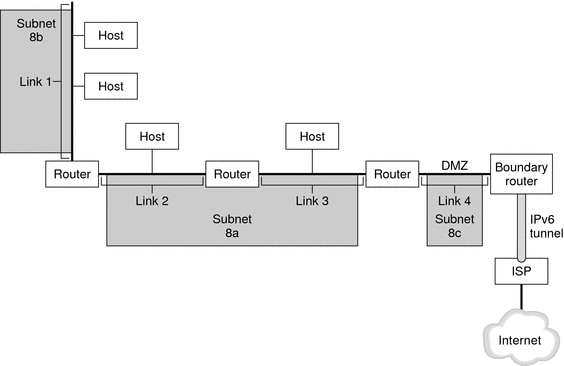| Previous | Next |
1. Solaris TCPIP Protocol Suite (Overview)
2. Planning an IPv4 Addressing Scheme (Tasks
3. Planning an IPv6 Addressing Scheme (Overview)
IPv6 Neighbor Discovery Protocol Overview
IPv6 Address Autoconfiguration
4. Planning an IPv6 Network (Tasks)
5. Configuring TCP/IP Network Services and IPv4 Addressing (Tasks)
6. Administering Network Interfaces (Tasks)
7. Enabling IPv6 on a Network (Tasks)
8. Administering a TCP/IP Network (Tasks)
9. Troubleshooting Network Problems (Tasks)
10. TCP/IP and IPv4 in Depth (Reference)
12. About Solaris DHCP (Overview)
13. Planning for DHCP Service (Tasks)
14. Configuring the DHCP Service (Tasks)
15. Administering DHCP (Tasks)
16. Configuring and Administering DHCP Clients
17. Troubleshooting DHCP (Reference)
18. DHCP Commands and Files (Reference)
19. IP Security Architecture (Overview)
21. IP Security Architecture (Reference)
22. Internet Key Exchange (Overview)
24. Internet Key Exchange (Reference)
25. Solaris IP Filter (Overview)
28. Administering Mobile IP (Tasks)
29. Mobile IP Files and Commands (Reference)
30. Introducing IPMP (Overview)
31. Administering IPMP (Tasks)
Part VI IP Quality of Service (IPQoS)
32. Introducing IPQoS (Overview)
33. Planning for an IPQoS-Enabled Network (Tasks)
34. Creating the IPQoS Configuration File (Tasks)
35. Starting and Maintaining IPQoS (Tasks)
36. Using Flow Accounting and Statistics Gathering (Tasks)
IPv6 Network Overview
This section introduces terms that are fundamental to the IPv6 network topology. The following figure shows the basic parts of an IPv6 network.
Figure 3-1 Basic Components of an IPv6 Network

The figure depicts an IPv6 network and its connection to an ISP. The internal network consists of Links 1, 2, 3, and 4. Each link is populated by hosts and terminated by a router. Link 4, which is the network's DMZ, is terminated on one end by the boundary router. The boundary router runs an IPv6 tunnel to an ISP, which provides Internet connectivity for the network. Links 2 and 3 are administered as Subnet 8a. Subnet 8b consists only of systems on Link 1. Subnet 8c is contiguous with the DMZ on Link 4.
As illustrated in Figure 3-1, an IPv6 network has essentially the same components as an IPv4 network. However, IPv6 terminology differs slightly from IPv4 terminology. Here is a list of familiar terms for network components as they are used in an IPv6 context.
- node
Any system with an IPv6 address and interface that is configured for IPv6 support. This generic term applies to both hosts and routers.
- IPv6 router
A node that forwards IPv6 packets. At least one of the router's interfaces must be configured for IPv6 support. An IPv6 router can also advertise the registered IPv6 site prefix for the enterprise over the internal network.
- IPv6 host
A node with an IPv6 address. An IPv6 host can have more than one interface that is configured for IPv6 support. As in IPv4, IPv6 hosts do not forward packets.
- link
A single, contiguous network medium that is bounded on either end by a router.
- neighbor
An IPv6 node that is on the same link as the local node.
- IPv6 subnet
The administrative segment of an IPv6 network. Components of an IPv6 subnet can directly correspond to all nodes on a link, as in IPv4. Nodes on a link can be administered in separate subnets, if required. Additionally, IPv6 does support multilink subnets, where nodes on more than one link can be components of a single subnet. Links 2 and 3 in Figure 3-1 are components of multilink Subnet 8a.
- IPv6 tunnel
A tunnel that provides a virtual point-to-point path between an IPv6 node and another IPv6 node endpoint. IPv6 supports manually configurable tunnels and automatic 6to4 tunnels.
- boundary router
The router at the edge of a network that provides one end of the IPv6 tunnel to an endpoint outside the local network. This router must have at least one IPv6 interface to the internal network. For the external network, the router can have an IPv6 interface or an IPv4 interface.
| Previous | Next |